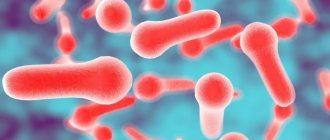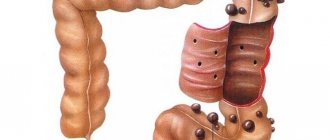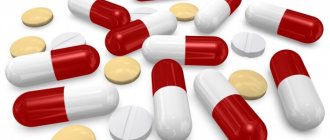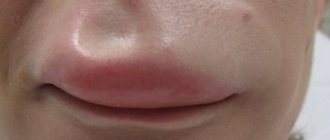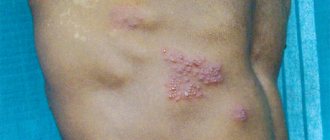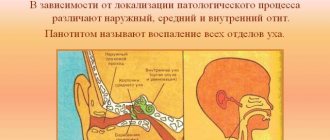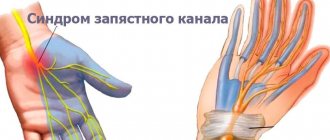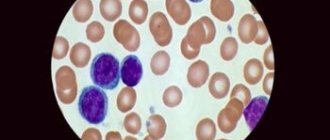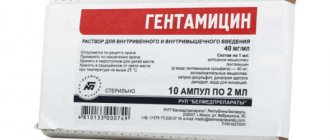A person’s face is capable of expressing all his thoughts, emotions and feelings without words. Facial expressions are a rich and versatile opportunity to show your mood, your assessment of what you saw or heard, your attitude to what is happening around you.
Therefore, impairment of the ability to control facial muscles is an unpleasant process with bad consequences. It can trigger its mechanisms due to the onset of inflammation of the facial nerve - a cause that can lead to severe functional consequences.
Features of the disease
Neuritis is inflammation of one of the seven pairs of cranial nerves. When the disease occurs, a person loses the ability to fully express emotions, chew food normally, and speak. The disorder has noticeable visual manifestations: half of the face is distorted, symmetry is distorted.
The photo shows the facial nerve
The facial nerve passes through narrow bone canals, making it very vulnerable. Even mild inflammation is fraught with constriction, followed by serious oxygen starvation. Most often, facial muscles are affected on one side, and only 2% of patients experience bilateral neuritis.
Neuritis can be divided into two categories:
- primary;
- secondary.
The primary inflammatory process occurs against the background of hypothermia, the secondary one is a complication of existing diseases of tonsilogenic or otogenic origin.
Trigeminal nerve
The trigeminal nerve (V pair of cranial nerves) got its name because it has three branches:
- ophthalmic;
- maxillary;
- mandibular
In terms of function, the two upper branches are sensitive, the mandibular branch is mixed, it contains both sensory and motor fibers.
This nerve provides sensation:
- meninges;
- skin of the face and parietal area;
- eyeball;
- nasal mucosa and sinuses;
- teeth and oral cavity.
It also regulates:
- formation of tears in the lacrimal glands;
- work of the salivary glands;
- innervates most of the masticatory muscles.
Inflammation of the trigeminal nerve is characterized by sharp pain in the affected half of the face, which intensifies with:
- chewing;
- conversation;
- yawn;
- brushing your teeth;
- touching the face, including when shaving or applying makeup.
The pain may not be localized over the entire half of the face, but in the area innervated by one of the branches of the trigeminal nerve.
The second symptom is:
- hyperemia (redness) of half the face;
- lacrimation;
- nasal discharge;
- increased salivation.
In the chronic course of inflammatory phenomena, the following occur:
- twitching of facial muscles and pathological sensitivity of facial skin as harbingers of a painful attack;
- atrophy of the facial muscles on the affected side, as a result of which facial expressions become asymmetrical;
- the development of neuroses against the background of frequent pain attacks is possible.
We also bring to your attention an article about facial nerve paresis in newborns.
Causes of neuritis of the facial nerve
All possible causes of inflammation of the facial nerve lead to narrowing and spasms of the arteries. Blood stagnates in the capillaries, which causes them to expand. The liquid part of the blood accumulates in the intercellular spaces, the outflow of lymph is disrupted due to swelling of the tissues and compression of the lymphatic vessels and nerves.
Poor blood circulation to a nerve is fraught with a lack of nutrition. The nerve trunk becomes larger, numerous hemorrhages occur , preventing impulses from being transmitted from the brain to the muscles.
The facial nerve becomes inflamed due to several reasons:
- local hypothermia;
- herpes;
- multiple sclerosis;
- depression and frequent stress;
- hypertension;
- alcoholism;
- sinusitis;
- otitis;
- diseases of the endocrine system;
- atherosclerosis.
Inflammation is also : at this time, women face serious hormonal changes and suppressed immunity, which negatively affects the state of the nervous system. During this period, the disease is more difficult to treat, since many drugs are dangerous to the fetus and are prohibited for use.
general information
Before explaining what facial neuralgia is, we should consider it in more detail.
What functions does it perform? The facial nerve is an element of the innervation system of the facial region. Providing sensitivity is its main function. In this regard, branches of this nerve are located on both sides of the face. They are “supplied” to each organ in the front of the head. Trigeminal neuralgia is a disease that is accompanied by a disorder of its functions.
It is characterized by short but extremely severe attacks of pain. In most cases, this pathology is accompanied by a chronic course. The acute period is replaced by a long period of calm. At this time, the patient does not feel pain.
Symptoms of facial neuritis
Symptoms of inflammation of the facial nerve on the face depend on the form of the pathology. It can be subacute or acute. First, aching or sharp pain appears in the ear area. An obvious sign of the disease - paralysis of the facial muscles - will appear 1-2 days after the onset of the disease.
Additionally, the following symptoms may occur:
- noticeable smoothness of the nasolabial fold;
- Bell's sign;
- drooping corner of the lips;
- mask-like appearance of the face;
- skewed to the healthy side;
- impaired salivation;
- hearing impairment.
Photo: symptoms of facial neuritis
During illness, a person becomes irritable and nervous; migraine attacks, insomnia and aching pain throughout the body are possible. Body temperature rises to 38 °C.
Pain in the affected area can be atypical or typical. In the first case, the discomfort is constant, wave-like: attacks occur unexpectedly, subside and repeat. Typical pain is sharp, shooting, similar to electric shocks in the area of nerve fibers.
Bell's symptom is characterized by visual impairment. When you try to close your eyes, your eyeballs move upward. On the affected side of the face it is impossible to close the eyelids completely; the white sclera is visible in the slightly open gap.
Signs of herpes in the ear canal
After the onset of the disease, the muscles of the affected side are weakened, which makes the simplest facial expressions impossible: smiling, eyebrow movements, winking. With the herpes virus, signs of Hunt's syndrome are added - acute constant pain appears in the ear area, radiating to the cervical-occipital region. Blistering rashes appear in the nasopharynx and external auditory canal.
Signs of inflammation of the facial nerve will help the specialist determine the affected area. If the pyramid of the temporal bone or the cranial cavity is damaged, salivation will decrease, the front of the tongue will lose the ability to detect taste, and hearing may become acute or lost.
When inflammation occurs in the nuclei of the facial nerve, nystagmus appears (rapid involuntary movements of the eyeballs), half of the face goes numb. Signs of damage to the cerebral cortex leads to paralysis of the facial muscles on the lower part of the face. When laughing, the asymmetry is not visible, but the patient is constantly haunted by a nervous tic.
Massage and self-massage
Massage for neuritis of the facial nerves can be performed by both a specialist and the patient himself. In the second case, you should know exactly how to do it. Below is a technique for performing self-massage for this disease.
- Place your hands on the areas of your face located in front of the ear. Massage and pull the muscles on the healthy half of the face down, and on the affected side – up.
- Close eyes. Use your fingers to massage the orbicularis oculi muscle. On the healthy side, the movement should go from above, outwards and downwards, and on the affected side, from below up and from the inside outwards.
- Place your index fingers on both sides of your nose. On the healthy side, stroke from top to bottom, and on the affected side, vice versa.
- Use your fingers to smooth out the muscles in the area of the corners of the lips. On the healthy side, from the nasolabial fold to the chin, and on the affected side, from the chin to the nasolabial fold.
- Massage the muscles above the eyebrows in different directions. On the healthy side to the bridge of the nose and down, on the affected side - to the bridge of the nose and up.
Necessary diagnostics
If alarming symptoms appear or neuritis is suspected, you should contact a neurologist . Treatment of inflammation of the facial nerve is carried out only after confirmation of the diagnosis and under the supervision of a specialist, which will avoid possible complications.
Despite the obvious visual symptoms, one examination and collection of complaints is not enough. Additionally, the following diagnostic measures may be recommended:
- general blood analysis;
- MRI;
- CT scan of the brain;
- electromyography;
- electroneurography.
A blood test is necessary to confirm the presence of an active inflammatory process in the body. The doctor will pay attention to the erythrocyte sedimentation rate, the content of lymphocytes and leukocytes. Using MRI, other pathologies that cause similar symptoms are excluded: inflammation of the meninges, heart attacks or tumors.
A CT scan can indicate the causes of neuropathy. Treatment tactics are selected based on the results of this study.
Traditional methods
It is important to understand that treatment of facial neuritis at home can only be carried out after consultation with a doctor. The use of traditional methods does not eliminate the need to seek qualified medical help. This is due to the fact that the use of unconventional methods helps to relieve unpleasant symptoms, but cannot completely eliminate the pathology. The use of traditional methods can be considered solely as an auxiliary measure.
The most effective are the following recipes:
- Take 40 g of propolis, grind it and pour vodka without additives or medical alcohol in a volume of 100 ml. Mix the ingredients thoroughly. Place the container on the fire. Simmer until the propolis dissolves in vodka or alcohol. Pour the resulting liquid into a dark glass bottle. Let it brew for a week. After 7 days, shake the bottle with the medicinal mixture. Mix the liquid with olive oil in a ratio of 1:5. Moisten a piece of gauze cloth in the resulting mixture. Apply it to the affected part of the face. The course of therapy should include 10 procedures.
- Treatment of facial neuritis at home is almost never complete without the use of honey. This is due to the fact that this healing product is a highly effective anti-inflammatory agent. Recipe for preparing medicinal mass: take 1 tbsp. l. honey, the white of one egg and juice squeezed from a large onion. The egg white must be thoroughly beaten; it should look like stable foam. Little by little add onion juice and honey melted in a water bath. Apply the resulting product to linen fabric. Apply a compress to your face. The number of procedures is 10. They need to be carried out daily.
- Regardless of the severity of the symptoms of facial neuritis, treatment of the disease with folk remedies should include taking royal jelly. The product must be used in its pure form. Dosage regimen: 5 mg three times a day. The duration of treatment is 3 weeks. Royal jelly is a remedy that has powerful healing properties. It helps to quickly relieve inflammation and pain.
- Treatment of facial neuritis at home can also be carried out using medical mustard plasters. To enhance the therapeutic effect, it is recommended to apply a mass consisting of vegetable oil, honey and propolis tincture (20%) on them. All components must be taken in equal proportions. Place a gauze cloth folded in several layers on the affected part of the face, and then place mustard plaster with a healing mass on it. Repeat the procedure every other day. The course of therapy includes 10 sessions.
- When treating neuritis of the facial nerve at home, it is recommended to take infusions and decoctions based on medicinal plants. Burdock root is a highly effective remedy for the disease. You need to take 4 tbsp. l. pre-dried and crushed raw materials and pour 1 liter of boiling water over it. Let the liquid sit for 12 hours. Strain. Take 50 ml 4 times a day before meals. You can also moisten a cotton or linen cloth in the resulting infusion and apply it to the affected part of the face.
- Cut off a few leaves of the golden mustache. Wash the raw materials and grind. Pour 200 ml of boiling water over the golden mustache. Place the container on the fire. Boil for 5 minutes. After this, remove the container from the heat, cool and strain. Take 10 ml three times a day before meals.
- Take 4 tbsp. l. pre-dried and crushed calendula flowers. Pour 1 liter of boiling water over the raw materials. Let the liquid sit for 3 hours. Strain. Drink the infusion three times a day before meals, 200 ml. To improve the taste, you can add honey to the liquid.
- Dilute the red clay with boiling water so that the consistency of the mass resembles thick sour cream. Cool the product slightly so that it does not burn the skin. Form a cake about 3 cm thick from the resulting mass. Place it on the affected side of the face. Secure the cake with plastic wrap. The duration of the procedure is half an hour. According to reviews, red clay copes well with neuritis.
- Collect black elderberries. Crush them to a paste. Apply the resulting mass to the site of pathology daily for half an hour.
It is important to understand that any natural remedy is a potential allergen. If signs of an adverse reaction occur, treatment of facial neuritis at home must be completed.
Possible complications
With timely and correct treatment of inflammation of the facial nerve, the prognosis is quite favorable. Poor quality therapy increases the risk of the following complications:
- facial synkesia;
- muscle atrophy;
- keratitis;
- chronic conjunctivitis;
- involuntary facial spasms;
- contractures of facial muscles.
Nerve cells take a long time to recover, and it is necessary to follow all the doctor’s recommendations: complete the full course of treatment, massage on time and take all prescribed medications. You also need to find out the causes of facial neuritis in order to protect yourself from relapse of the disease.
Physiotherapeutic treatment
Physiotherapy has a very beneficial effect as an additional treatment for neuritis (neuralgia) of the facial nerve. Ultra-high frequency waves (UHF), ultraviolet rays, electrophoresis with drugs, treatment using diadynamic currents, darsonvalization, applications of medicinal substances, ozokerite, and mud therapy are used. After active manifestations subside, balneological resorts are recommended.
Massage has special therapeutic properties. Special techniques have been developed that are most effective for neuritis. Acupuncture has been successfully used.
Treatment of neuritis of the facial nerve
In order for the treatment of inflammation of the facial nerve to be effective, you cannot get away with eliminating the symptoms - complex therapy is needed. From the first days of the disease, drug treatment is necessary; physiotherapy with the use of non-contact heat is allowed. From the second week, physical therapy and massages are included. Noticeable improvements should appear within the first 2-3 months.
Medications
If the nerve is inflamed, the main “bet” is on glucocorticoids - steroidal anti-inflammatory drugs: Prednisolone or Dexamethasone. They relieve inflammation, eliminate pain and reduce swelling. The release of a neurotransmitter is activated - a substance that improves the conduction of impulses along the nerve fiber.
Additionally, the following may be assigned:
- Diuretics: Furon, Furosemide. Frees tissues from fluid that causes swelling, reduces the risk of squeezing blood vessels.
- Anticholinesterase: Galantamine, Proserin. Increase muscle tone, normalize the functioning of the excretory glands (salivary and lacrimal).
- Non-steroidal anti-inflammatory drugs: Nurofen, Nise. Relieves inflammation along the nerve fibers, relieves pain in the ear and eye areas.
- Vitamins: group B. Necessary for the proper functioning of the nervous system and its protection from the effects of toxins.
Antiviral: Acyclovir, Zovirax. Prescribed for the herpes virus, they block the division of its cells.
- Antispasmodics: Spasmol, No-spa. Dilate arteries, relieve spasms of smooth muscles. Improves blood circulation on the affected side of the face.
- Neurotropic: Phenytoin, Levomepromazine, Carbamazepine. They normalize the mineral metabolism of nerve cells, reduce the frequency of involuntary muscle contractions and improve the functioning of the entire nervous system.
Before using any drug, you must read the instructions for use and the list of contraindications. Any medication can trigger an allergic reaction or cause side effects. If undesirable consequences occur, you should inform your doctor.
Massage
It is recommended to start massage 5–7 days after the facial nerve becomes inflamed. If possible, it is better to consult a specialist: incorrect independent influence can negatively affect the course of the disease .
Immediately before the procedure, a warm-up is carried out: the head is tilted back and forth, rotated and turned. Each exercise is done slowly, 7–10 times. The massage itself begins with the neck and back of the head to prepare the lymphatic vessels.
The effect is on both sides of the face and head: the one on which the nerve is inflamed and the healthy one. It is imperative to stretch the collar area and mastoid process.
In the first 2–3 days, all actions should be soft and smooth, superficial: too intense contact is dangerous due to painful muscle contractions.
The average session duration is no more than 15 minutes. It is recommended to carry out a massage until recovery occurs and all symptoms of neuritis disappear.
Photo: restoration of facial expressions after neuritis
ethnoscience
Folk remedies are often used as an auxiliary effect in the treatment of an inflamed nerve. They cannot fully replace drug treatment, but they improve overall well-being and speed up the healing process.
With the approval of a doctor, the following are used:
- Rubbing: a prepared 10% mummy solution is applied to a cotton swab, which is used to massage the face for 3–5 minutes. The movements should be light and move from the center to the ear area. The duration of the course is 14 days.
Warming up:
clean sand or table salt (200–250 grams) are calcined in a frying pan. The mixture is placed in dense tissue and applied to the area of the inflamed nerve for 20–30 minutes. You can start the procedure on the seventh day after the start of the main treatment.- Compresses: 3 sachets of chamomile are brewed in a glass of boiling water and left for 15 minutes. The liquid is drained, and the wet bags are applied to the face, covered with cling film and a warm cloth. The procedure can be done once a day while the main drug treatment is being carried out.
- Ointment: two tablespoons of dry or fresh poplar buds are crushed in a blender, the same amount of soft butter is added. Apply to the problem area of the face after warming up. You can treat inflammation in this way for 14 days.
To strengthen the immune system, herbal teas and infusions with natural liquid honey are additionally recommended.
Any component of a folk remedy can be an allergen, so when the first side effects appear, the recipe is banned.
Surgery
If treatment of inflammation of the facial nerve takes longer than 6–8 months, and there is no obvious improvement, doctors recommend surgery.
This method should be used during the first year of the disease: neuritis provokes changes in the facial muscles, and over time they become irreversible.
In most cases, surgery is required for ischemic disease, when the nerve compresses the narrow fallopian canal. This disorder is provoked by trauma to the skull bones or chronic inflammation of the middle ear.
During the procedure, an incision is made behind the pinna to locate the area where the nerve exits the stylomastoid foramen. The outer wall of the canal is removed to stop the process of compression of the nerve by the temporal bone. The operation is performed under general anesthesia and has a high success rate.
Physiotherapy
There are several treatments for facial neuritis. According to medical reviews, physiotherapy significantly speeds up the healing process.
The most effective procedures:
- UHF. This method of treating facial neuritis is based on the ability of tissues to partially absorb an ultra-high frequency electric field. During the procedure, charged particles enter the cells, which normalizes metabolic processes. Locally, tissue temperature increases, blood circulation in the affected area improves, and swelling disappears. In addition, during physiotherapy, the number of blood cells increases, the task of which is to destroy pathogenic microorganisms. The duration of the procedure is no more than 15 minutes. The course of treatment consists of a minimum of 5 and a maximum of 15 sessions.
- UV. The essence of the method is to expose the affected part of the face to ultraviolet rays. The latter help accelerate the production of hormones and immunoglobulins. The natural consequence is the relief of painful sensations and a decrease in the severity of the inflammatory process. The biodose is determined by the doctor on an individual basis. The course of treatment can include up to 20 procedures.
- DMV. The essence of the method is to influence the source of pathology with electromagnetic decimeter waves of ultra-high frequency. As a result, pronounced heating of the tissue occurs. Due to this, metabolic processes are activated, blood vessels dilate, tissue nutrition is improved and, accordingly, the functioning of the damaged nerve is restored. The duration of the procedure is 5-10 minutes. The course of treatment includes from 3 to 15 sessions.
- Electrophoresis using drugs. During the procedure, the source of pathology is exposed to a constant, continuous electric current. At the same time, it has minimal strength and tension indicator. With physiotherapy, the inflammatory process is stopped, pain and swelling disappear. Using current, medications are injected into the pathology site. This allows you to achieve maximum concentration of active components in the affected area.
- Diadynamic therapy. The essence of the method is as follows: constant pulsed currents pass through the skin and penetrate the muscle fibers, due to which the latter begin to contract. This process is very important. This is due to the fact that the muscles have not functioned for a long time and have weakened significantly. During diadynamic therapy, the tissues are strengthened. In addition, excess fluid is released from the cells, nerve fibers are restored, and the production of special protective enzymes is activated.
- Paraffin applications. They have several mechanisms of action: chemical, mechanical and thermal. Thanks to this, the functioning of the facial nerve is restored very quickly. In addition, paraffin applications are an excellent prevention of all kinds of complications. The duration of the session is about 40 minutes. The course of treatment includes from 10 to 20 procedures.
Regardless of the severity of symptoms, treatment of facial neuritis using physiotherapeutic methods should begin no earlier than 7 days from the development of the inflammatory process. Ignoring this condition can lead to a worsening of the pathology.
Doctors recommend avoiding hypothermia of the face during treatment. In winter, it is advisable to cover the affected area with a scarf. In addition, experts advise staying in the room for another quarter of an hour after any procedure.
Prevention
Primary neuritis is much easier to treat. If inflammation of the facial nerve occurs again on the same side of the face, the prognosis is less favorable and the chances of a full recovery are reduced. To avoid relapse it is recommended:
- avoid stress and long-term depression;
- to harden;
- provide yourself with adequate nutrition;
- avoid hypothermia;
- carry out self-massage throughout the year;
- get rid of viral and infectious diseases in a timely manner.
Immediately after treatment, it is important to choose the appropriate vitamin and mineral complex and include as many vegetables and fruits in your diet as possible to support the immune system.
The final decision on how to treat facial neuritis is made by the doctor. Trying to choose therapy on your own is dangerous by worsening the course of the disease and the rapid appearance of complications. After this, the only way to get rid of the disease will be surgery.
Features of treatment in children
According to statistical data, pathology is very rarely diagnosed in children. The main cause of the development of facial neuritis in children is birth trauma. In addition, the disease can occur after hypothermia, as well as against the background of various ailments of an infectious nature.
Treatment of facial neuritis in children is similar to that shown for adults. The main goals of therapy are to normalize the functioning of the damaged fiber, eliminate swelling, relieve inflammation and pain, and improve microcirculation.
Treatment of facial neuritis in children with severe asymmetry involves a course of massage. The first session should take place no earlier than a week after the development of the pathology. This is due to the fact that any exposure at the beginning of the acute period can lead to irreversible consequences.
The first few massage sessions should be performed by a doctor. Then it is allowed to carry out manipulations at home.
Treatment of facial neuritis also involves regular special exercises. A set of exercises is compiled by a doctor in each individual case. The specialist takes into account the child’s age, the severity of the neuritis, as well as the presence of concomitant ailments.
Drug effects
If a patient is diagnosed with facial neuralgia, treatment should be aimed at eliminating the cause of its occurrence. All this must be confirmed by thorough diagnostics. It is also necessary to make a differential comparison with the following head pathologies:
- Tumors.
- Vascular.
- Infectious.
As a rule, if facial neuralgia is detected, treatment includes taking several drugs from the following group:
- "Tebantin."
- "Carbamazepine".
- "Difenin."
- "Oxcarbazepine."
- "Acediprol."
In most cases, the drug of choice is Carbamazepine. However, it has many side effects. For this reason, its use requires regular assessment of liver function and monitoring of blood counts.
As for the course of treatment itself, it can be long. At the same time, the dosage is gradually reduced. In case of ineffectiveness of the first line, second-line drugs are used, which belong to the same pharmaceutical group. Among them:
- "Phenytoin."
- "Difenin."
- "Finlepsin".
In a situation where the facial nerve is cold, it is necessary to immediately begin treatment of the disease. When inflammatory processes are caused by the presence of internal provoking factors, therapy should be aimed at eliminating the main cause of neuralgia.
When the disease is diagnosed in the early stages of development, glucocorticosteroid drugs are used to relieve inflammation. Among them, medications such as Dexamethasone and Prednisolone should be highlighted.
If there is a pronounced pain syndrome, the patient is prescribed anti-inflammatory drugs that do not contain steroids. This category of medicines is manufactured in the form of ointments, tablets and solutions for the preparation of injections.
Since this disease is accompanied by a malnutrition of the trigeminal nerve, vasodilators are used to normalize blood circulation. From this category of medicines, medications such as Trental and Eufillin should be highlighted.
To reduce swelling in the face, diuretics like Triampur and Furosemide are used. In addition to all of the above, complex therapy includes the use of B vitamins to normalize metabolism in the body.
Facial neuritis usually develops gradually
Causes of this nervous system disease
The main factor of the disease is considered to be deformation of the trigeminal nerve by nearby veins or arteries that have lost their original physical shape.
The cause will be overgrown sclerotic plaques or tumors. Among other factors of this disease: https://feedmed.ru/bolezni/nervnoj-sistemy/nevralgiya-licevogo.html
- Multiple sclerosis, leading to damage to the sheath of nerve fibers.
- Viral infection: herpes, flu, etc.
- Inflammatory diseases of the posterior cranial fossa (arachnoencephalitis, meningoencephalitis) or middle ear (otitis).
- Traumatic brain injuries.
- Postponed surgeries.
- The weakening of the immune barrier causes the revival of various infections.
- Physical and psycho-emotional stress, poor quality nutrition and many other reasons.
- Hypothermia of the whole body or the facial and ear parts of the head.
- This can happen due to being in a draft, for example, while sleeping under an open window or near an open window in a speeding car.
- Heredity.
The course of the disease can be long, lasting for years. Exacerbations alternate with periods of calm, the duration and frequency of which vary. For some, the disease may manifest itself in rare, isolated episodes.
Popular recipes
- Birch buds need to be infused with vodka. For 0.25 liters you need to take three spoons of raw materials. The buds are infused for twenty days. After this, compresses should be applied to the affected area daily.
- You need to grate the horseradish. It is applied to the skin of the face for about 10 minutes. In this case, it is used as a lotion.
- You need to collect lilac buds. 50 g will be enough. Next you will need 300 ml of water. The kidneys are boiled for 15 minutes. Next, you need to melt two tablespoons of pork fat. A decoction (1 tbsp) is added to it. The resulting ointment should be used every day. Compresses are made from the decoction and should be applied for 30 minutes.
- For this disease, it is very useful to drink teas from the following herbs every day:
- St. John's wort.
- Raspberry leaves.
- Fireweed.
- Mint.
The above plants help relieve inflammation, improve the body's resistance and relax muscles. All patients must remember that adequate therapy for neuralgia can only be prescribed by a doctor. In this case, you cannot self-medicate.
Specialized gymnastics
Contraction and movement of the facial muscles will help relieve the condition during the next attack of pain. This also helps reduce future nerve compression. Such gymnastics brings significant benefits. In particular this applies to the following:
- The development of stagnation in the muscles is prevented.
- The conductivity of nerve impulses is restored (if it was disrupted).
- Lymph outflow is optimized.
- Blood circulation improves.
It is recommended to perform exercises in front of a mirror. Thanks to this, the process is better controlled. One gymnastics session involves performing the following exercises:
- Raising the eyebrows upward (at the same time the forehead is fixed with the hand).
- Closing and opening of the eyes (while the eyelids are strongly compressed).
- Cheek retraction.
- Bringing your lips together into a “tube”, stretching them into a smile.
- Inhalation of air and its subsequent exhalation through the gap in the lips.
- Pull the head and neck towards each shoulder (as far as possible).
- Circular rotations of the head and tilts.
Clinical picture
All manifestations of pathology are usually concentrated along the nerve trunk, which is exposed to pathological effects. We are talking about the following areas:
- Cheeks.
- Brows.
- Forehead.
- Jaw.
As a rule, the points where the nerve approaches the epidermis are the most painful. In this case, we mean the chin and eye socket. Facial neuralgia has a characteristic feature. It usually affects only one side.
Although in some cases there is also a bilateral form. Patients experience different sensations. However, in most cases there are general manifestations that indicate that the patient has facial neuralgia.
Symptoms are most often the following: unbearable, burning pain that can last from a few seconds to several minutes. As a rule, unpleasant sensations appear in the nasolabial triangle.
They then spread over wider areas. In the case of spontaneous neuralgia, a person may suddenly freeze. Sometimes he starts rubbing his face intensely. Sudden pain can radiate to the scalp, teeth, ears and even fingers.
Peak pain is very common. This occurs because the muscles near the affected nerve go into spasm. The clinical picture of the disease is complemented by other symptoms, among which are the following:
- Uncontrollable tearing.
- Burning sensation after intense pain stops.
- Uncontrollable drooling.
- Redness of the facial skin (in the form of spots or general).
- No pain at night.
- Reducing discomfort after strong pressure on the skin.
1 smooth forehead 2 impossible to close the eyelid 3. drooping corner of the mouth 4. facial nerves
Facial neuritis develops slowly.
- At first, only pain behind the ear may appear.
- After a few days, facial asymmetry appears. In this case, there is a smoothing of the nasolabial fold on the affected side, and drooping of the corner of the mouth.
- Also, the patient cannot close the eyelids on the same side, and when trying to do this, Bell’s symptom appears - the eyeball turns upward.
- The patient cannot bare his teeth, smile, raise his eyebrows, close his eyes, or make his lips appear like a tube.
- On the affected side, the eyelids are wide open, the eyeball seems to be pushed forward (lagophthalmos). The symptom of a “hare’s eye” is always present - a white strip of sclera is visible between the iris and the lower eyelid.
We suggest you read: Treatment of cysts on the upper eyelid
Since the facial nerve has several bundles that provide sensory innervation, the following symptoms may occur:
- loss of taste sensitivity in the anterior third of the tongue
- salivation
- dry eye or, conversely, lacrimation
- Some patients exhibit an interesting feature. Dry eyes cause tearing when eating
- A number of patients experience hyperacusis - ordinary sounds seem loud and too harsh to them
Extracranial part
After leaving the skull, the course of the facial nerve turns upward and goes to the front of the external ear. The first extracranial branch is the anterior auricular nerve. It provides motor innervation to some of the muscles near the ear. Near it, motor branches go to the posterior belly of the digastric muscle and the stylohyoid muscle.
The main trunk of the nervus facialis, which is called the motor root of the facial nerve, branches back and forth, passing near the parotid salivary glands, which are innervated by the glossopharyngeal nerve. Near the parotid salivary glands, the nervus facialis branches into five terminal branches:
- Temporal branch - innervates the muscles of the forehead, orbicularis and those responsible for wrinkling the eyebrows.
- The zygomatic branch controls the orbicularis orbitalis muscle.
- Buccal branch – controls the orbicularis oris, zygomatic and buccal muscles.
- The branch of the edge of the lower jaw is responsible for the muscle of the chin.
- Cervical branch - controls the platysma, the subcutaneous muscle of the neck.
These motor terminal branches of the facial nerve innervate the muscles that give the face a certain expression. When the extracranial part of the facial nerve is injured, paralysis or severe weakness of the muscles of facial expression occurs, which leads to various pathologies.
Additional therapeutic measures
When the facial nerve is cold, treatment is selected on an individual basis. Centrally acting muscle relaxants are often prescribed, including:
- "Sirdalud".
- "Baklosan."
- "Baclofen."
The above drugs help eliminate muscle spasms. Patients are recommended to take antidepressants before going to bed. Trazodone and Amitriptyline are often prescribed. B vitamins are also administered intramuscularly.
We suggest you read: Testicular cyst in a 14-year-old teenager
If the facial nerve is cold, then special creams and ointments can be applied topically. They must contain non-steroidal anti-inflammatory components. These medications will help relieve pain. The most commonly used drugs are:
- "Diclofenac".
- "Bystrum-gel".
- "Diklak."
One of the effective measures to relieve pain if the patient has an inflamed facial nerve is massage. The patient can perform it independently. Before doing this, you must consult your doctor.
- Light vibrating movements in the cheeks and cheekbones.
- Rubbing arms, neck, shoulders.
- Stroking the back of the head.
- Massage in the area of the nasolabial triangle, forehead, eyebrows (carried out with fingertips).
Each movement should be performed without strong pressure. A vibration massager can be used. However, before doing this, you should consult your doctor. Sessions last up to 5 minutes daily. The course includes 25 procedures.


